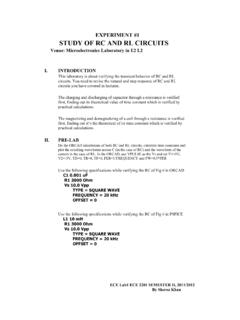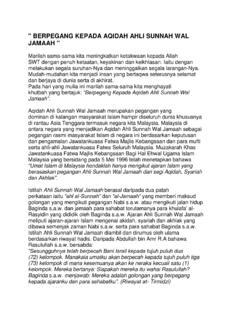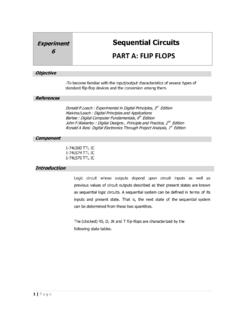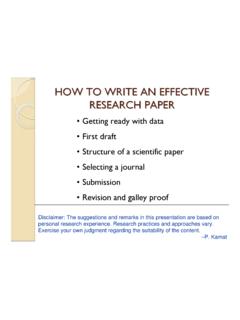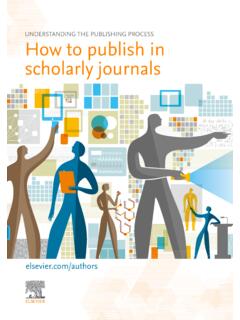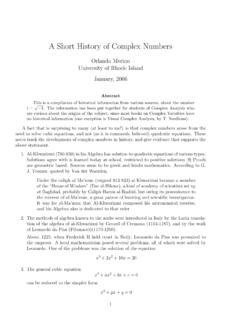Transcription of Writing a scientific article: A step-by-step guide for ...
1 European Geriatric Medicine 6 (2015) 573 579. Available online at ScienceDirect Research paper Writing a scienti c article: A step-by-step guide for beginners F. Ecarnot *, Seronde, R. Chopard, F. Schiele, N. Meneveau EA3920, Department of Cardiology, University Hospital Jean-Minjoz, 3, Boulevard Fleming, 25000 Besanc on, France A R T I C L E I N F O A B S T R A C T. Article history: Many young researchers nd it extremely dif cult to write scienti c articles, and few receive speci c Received 22 June 2015 training in the art of presenting their research work in written format. Yet, publication is often vital for Accepted 18 August 2015 career advancement, to obtain funding, to obtain academic quali cations, or for all these reasons. We Available online 19 September 2015. describe here the basic steps to follow in Writing a scienti c article. We outline the main sections that an average article should contain; the elements that should appear in these sections, and some pointers for Keywords: making the overall result attractive and acceptable for publication.
2 Scienti c publications 2015 Elsevier Masson SAS and European Union Geriatric Medicine Society. All rights reserved. Writing Research Article 1. Background which only small amounts of time can be devoted on an irregular basis. However, the competition is already quite erce amongst all Every researcher has been face to face with a blank page at some the good quality papers that are submitted to journals, and it is stage of their career, wondering where to start and what to write therefore of paramount importance to get the basics right, in order rst. Describing one's research work in a format that is for your paper to have a chance of succeeding. Don't you think that comprehensible to others, and acceptable for publication is no your work deserves to be judged on its scienti c merit, rather than easy task. When you invest a lot of time, energy and often money in be rejected for poor quality Writing and messy and confusing your research, you become intimately and emotionally involved. presentation of the data?
3 Naturally, you are convinced of the value of your research, and of With this in mind, we present here a step-by-step guide to its importance for the scienti c community. However, the Writing a scienti c article, which is not speci c to the discipline of subjectivity that goes hand in hand with deep involvement can geriatrics/gerontology, but rather, may be applied to the vast make it dif cult to take a step back, and think clearly about how majority of medical disciplines. We will start by outlining the main best to present the research in a clear and understandable fashion, sections of the article, and will then describe in greater detail the so that others likely, non experts in your eld can also main elements that should feature in each section. Finally, we will appreciate the interest of your ndings. also give a few pointers for the abstract and the title of the article. Even today, the old adage publish or perish'' remains valid. This guide aims to help young researchers with little experience of Many young researchers nd themselves under pressure to Writing to create a good quality rst draft of their work, which can produce scienti c publications, in order to enhance their career then be circulated to their co-authors and senior mentors for prospects, or to substantiate requests for funding, or to justify further re nement, with the ultimate aim of achieving publication previous funding allocations, or as a requirement for university in a scienti c journal.
4 It is undoubtedly not exhaustive, and many quali cations such as a Masters degree or doctoral thesis. Yet, excellent resources can be found in the existing literature [1 7]. often, young doctors do not have much training, if any, in the art of and online [8]. Writing a scienti c article. For clinicians, in particular, the clinical workload can be such that research and scienti c Writing are seen 2. Getting started: things to do before you write a word to be secondary activities that are not an immediate priority, and to A certain amount of preparatory work needs to be done before you ever write a word of your article. This background work should * Corresponding author. Tel.: +33 381 668 539; fax: +33 381 668 582. generally already have been accomplished by the time you are at E-mail addresses: (F. Ecarnot), ( Seronde), the Writing stage, because it also serves as background to the (R. Chopard), (F. Schiele), research project you are Writing about. All the time you invest in (N. Meneveau).
5 Preparing the protocol for your project is an advance on the Writing 1878-7649/ 2015 Elsevier Masson SAS and European Union Geriatric Medicine Society. All rights reserved. 574 F. Ecarnot et al. / European Geriatric Medicine 6 (2015) 573 579. of the article that will come out of your project. Thus, you probably Below, we will discuss each of these sections in detail, outlining the already performed an extensive literature review to establish the main points to keep in mind when Writing them. current state of knowledge on the topic, and ensure the originality of your research when developing the protocol, and this can serve The introduction section for your paper . It is helpful, when you are reviewing the literature, to take notes of important points or phrases that you intend to The introduction is of prime importance in grabbing the include in your article, with the relevant references. A software reader's attention (Table 1). In particular during the review program for managing references (either free versions or process, the introduction must get the reviewer hooked'', wanting commercially available products) can be helpful for managing to read more, and thinking to themselves, How come I never the large volume of references that you are likely to wade through thought of this?
6 ''. In this section, you will thus explain why you before sifting out the most important points. undertook your study, what you aimed to achieve with it, and how Usually, you will also have the nal results of the statistical this constitutes a useful addition to the existing body of evidence analysis of your data. This will form the basis of your results on this topic. section. Some of the graphical representations of your results will In concrete terms, you should start by explaining brie y, using serve as gures for the article, so it is helpful to highlight the most appropriate references, what is already known about this subject. important ndings as you read through the results so that you do You should then narrow the eld down somewhat and identify the not forget anything important. areas where there is still some uncertainty, citing, where Before starting to write, you should identify the target journal in appropriate, any previous (and possibly con icting) data. This which you intend to submit your research.
7 This will have will logically lead to a description of an explicit gap in the consequences for the formatting, but more importantly, for the knowledge that your study hopes to ll. This is an essential orientation of your Writing style, since the Writing must be element in justifying the utility of your work. Having now appropriate for the type of reader you are targeting. For example, explained how your study is going to contribute something new are you targeting a specialist journal, where readers are expected and useful, you should clearly state your working hypothesis, to be experts in your eld, or a general medicine journal, where followed by your objective(s), and very brie y, the strategy readers may be experts from other disciplines? This will have implemented to achieve these goals (Table 1). implications for the amount and type of information that you must In the background, the reasons that prompted you to undertake include. In addition, the editorial policy of the target journal should your research should be clear to the reader, and justi ed by the also be taken into account.
8 For instance, in a given area of expertise, state of scienti c knowledge with appropriate references. It is not some journals favour papers reporting basic research, whereas necessary to cite every article in the literature on the topic; a other journals give precedence to more clinical work. The choice of careful selection of the most pertinent publications is suf cient. the target journal depends on a range of factors, which are beyond Similarly, it is not necessary to state universal truths that may the scope of this article. However, at the very least, you should seem over simplistic or eminently obvious. Yet you should try to check that your paper falls within the scope of the journal you have achieve a suitable balance between relevant background informa- chosen. tion, and excessive detail. In this regard, you should keep in mind the target audience you are aiming for. This will depend on the pro le of the readership of the journal in which you intend to 3. What are the main sections of a scienti c article?
9 Submit your research, as mentioned above. If you are targeting a specialty journal, then your background can be more detailed and The vast majority of scienti c journals follow the so-called technical than if you are addressing an audience of non-specialists IMRAD'' format, introduction, methods, results and discussion. in your eld. Naturally, there are some exceptions to this rule, and you should The introduction should logically ow towards the identi ca- always check the instructions for authors of the journal where you tion of the gap in knowledge that you hope to ll. This is your plan to submit your paper to ensure that this is indeed the opportunity to state the added value of your study, or the new recommended format. For the purposes of this guide , we will only information that your study will yield. Will your results change discuss the IMRAD format, as it is the most widely used. clinical practice? Will they help the scienti c community at large Your article should thus contain (in this order) an introduction, to move towards consensus on a previously controversial topic by a methods section, a results section and a discussion.
10 Added to this providing hard evidence in one direction or the other? This is your will be the abstract, which is more or less a summary of these main chance to make a sales pitch for your article, in the appropriate sections, and of course, the title. At the end, there must be a list of terms, of course. bibliographic references, the tables, and the legends to any gures. As far as possible, try to avoid diverging from the subject at Finally, there may also be some other optional sections, such as hand. Every sentence should serve a purpose. Many journals have a acknowledgements, con icts of interest or authors' contributions. limit on the length of the introduction, with a maximum number of Table 1. Outline of the main features of the Introduction section, with examples. Feature Example Background describing what is known on the subject Percutaneous coronary intervention is the cornerstone of therapy for acute coronary syndromes, but may be associated with procedure-related complications What is not known?


